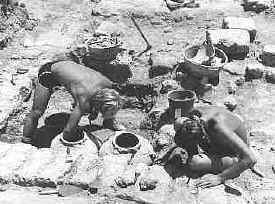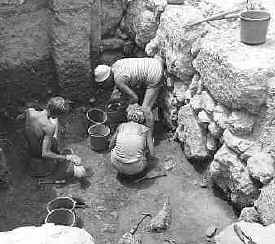Travel
Search
ARCHAEOLOGICAL EXCAVATIONS AT TEL DOR |
|
Harlan Hague |
One of the most thrilling experiences of my life came when I picked up three small shards on a wild stretch of the Gila River in central Arizona. The pieces were later identified as the work of the Hohokam, "the ancient ones," who lived in the American Southwest long before the arrival of Europeans in the western hemisphere in the sixteenth century.
My three shards are not important, historically or scientifically. Museums and private collectors own some fine, virtually undamaged, Hohokam pottery. But I found these. When I held those three pieces of smooth clay and looked around the sagebrush-covered flat where I picked them up, I felt very close to the ancient craftsman who had fashioned the bowl from which they came. The shards are now in a frame on my study wall.
That experience hints at my fascination with archaeological excavation. If you are as enchanted as I, as only a nonprofessional can be, perhaps you also have dreamed of someday taking part in a dig. You can. Now it's not necessary simply to watch excavations or read about them. There are expeditions in various locations throughout the world which welcome amateurs to take part. The most intriguing one I have come across is the dig at Tel Dor in Israel.
Located on the coast sixteen miles south of Haifa, Dor was one of the largest cities of ancient Israel. The site is known to have been occupied by Bronze Age, Canaanite, Israelite, Assyrian, Phoenician/Persian, Hellenistic, Roman and Byzantine peoples.
Tel Dor was never lost to scholars. There are numerous scriptural references to the city. The first historical record of Dor dates from the reign of the Egyptian Pharaoh, Rameses II (1304-1237 B.C.), but there is shadowy evidence that Neanderthal man may have lived here, pushing back the date of earliest occupation possibly to 30,000 years ago.
The site is rich in history. Dor was one of a coalition of Canaanite cities that was subdued by the Israelites under Joshua. Circumstantial evidence suggests that Dor itself finally was captured by David. The city eventually served as an administrative center for Solomon and was governed by his son-in-law. The city was one of the three ports of ancient Israel.
The Assyrians conquered and destroyed Dor in 732 B.C. (The tragic result of the siege was verified during a recent excavation by the discovery of burnt bricks and charred beams.) The Assyrians rebuilt the city and made it their provincial capital. Later, it became an administrative center for the Persians before passing to Eshmunessar, the King of Phoenician Sidon.
Dor remained a Phoenician city for centuries before its transformation into an independent city-state in the Hellenistic empire. During this era, Dor fell first under the domination of the Ptolemies of Egypt, who built its massive fortifications, and then the Seleucid rulers of Syria.
The construction of the port city of Caesarea by Herod the Great in 30 B.C. proved the beginning of the decline of Dor, though it still flourished during the early Byzantine period. The site was virtually abandoned following the Arab conquest of the region in the seventh century.
Crusaders recognized the strategic value of the place and erected a small castle in the thirteenth century, almost modern by Dor standards. For the next six hundred years, the Crusader ruins were the only evidence that the site had ever been occupied. It was simply a lonely, windswept mound overlooking the countryside and the ocean, seldom visited, largely forgotten.
That has all changed now. Dor is occupied once again, and the city is in the process of a rebirth--backwards. Since 1980, an international consortium has been excavating the site and plans to continue until the year 2000.
 The results so far, to put it mildly, have
been spectacular. Excavations in the forty-acre site have already yielded unmistakable
evidence of all the civilizations known to have occupied Dor. Walls, gates, and streets
have been found. A Hellenistic/Roman theater has been located, and a Hellenistic apartment
house has been cleared. Coins, jewelry, figurines, sculpture and pottery vessels, both
local and imported, have been uncovered.
The results so far, to put it mildly, have
been spectacular. Excavations in the forty-acre site have already yielded unmistakable
evidence of all the civilizations known to have occupied Dor. Walls, gates, and streets
have been found. A Hellenistic/Roman theater has been located, and a Hellenistic apartment
house has been cleared. Coins, jewelry, figurines, sculpture and pottery vessels, both
local and imported, have been uncovered.
Preliminary investigation of Dor's harbors has yielded the remains of a Bronze Age wharf dated around 1400 B.C. and a set of sheds where Hellenistic war galleys were stored. Underwater shipwrecks have been found: Roman, Byzantine, Crusader, seventeenth century and a fifth yet unidentified.
Not all the discoveries are made by professional archaeologists. On a recent dig, the project director watched a young woman uncover a rounded pottery fragment. He knelt beside her, and they worked together, carefully brushing away the loose soil, and there it was. The student had discovered not a fragment, but a complete, almost undamaged two-thousand-year-old storage jar. This was the first of a half dozen vessels in what turned out to be a Hellenistic storeroom.
On another day, a worker drove a pick into a wall, then jumped back in surprise when something tumbled from a cavity in the wall and rolled to her feet. The amateur archaeologist, a school teacher, had discovered a marble head of Zeus, the supreme deity of the ancient Greeks. Later, an unsuspecting worker tugged aside a stone in the wall to reveal a marble torso. The unknown wall-builder had put the priceless statuary to a practical use, as a building-block.
Plans are complete for the 1986 summer excavations, and you are invited to join the dig. Not as a spectator, mind you, but to get down on your hands and knees and dig down through history, and at the same time, make history. This is a rare opportunity for nonprofessionals to become personally involved in one of the most important archaeological excavations of the century. Experience is not necessary, only an interest in archaeology.
The Dor team will fly directly to Jerusalem for a five-day orientation session. Members will receive an introduction to the archaeology of Israel, including visits to the Israel Museum. One day will be devoted to a walking tour of the Old City to see its many important archaeological and historical sites. The group will visit Masada, site of Herod's palace fortress and the last refuge of the Zealots, Qumran where the Dead Sea Scrolls were discovered, and Jericho, one of the earliest walled cities.
 Once at
Dor, the
team will live at nearby Pardess-Hanna Agricultural School. The school has its own
swimming pool, easy access to public transportation and is adjacent to a small town. There
is a kibbutz nearby.
Once at
Dor, the
team will live at nearby Pardess-Hanna Agricultural School. The school has its own
swimming pool, easy access to public transportation and is adjacent to a small town. There
is a kibbutz nearby.
The day at Tel Dor begins early. The crew wakes up to coffee, tea, bread and jam and is on the site at dawn. After two or three hours of work, there is a break for breakfast at about 8:30. Then back to work for an hour and a half followed by rest and fruit. Excavation continues until about 1:00.
Back at the college, the crew has lunch, and the afternoon is free. At 4:30, everyone gathers for coffee and cake, lectures and "pottery reading." Members surprise themselves by quickly becoming expert in identifying pottery by types and civilization, and they find it fascinating. (Participants are permitted to collect pieces from the excavation discards--and there are mountains of discards at this rich site--to carry or ship home.) Dinner is at 6:30, followed by more lectures and free time.
During the six-week session, the crew will take two Saturday field trips to other important archaeological sites. There will be four free weekends (one is three days) for independent travel. A glance at a map will show the abundant attractions close at hand: Haifa, Acre, Nazareth, Tiberius and the Sea of Galilee just for starters.
California State University in Sacramento, California is a sponsor of the Tel Dor Project. The program is a field school combining excavation, laboratory work and lectures. Excavation staff members will lecture on Biblical archaeology, analytical and field techniques and regional history. Participants will be able to take part in all phases of archaeological fieldwork, from excavation to recording, photography and laboratory analysis.
It's not all work and no play. There is leisure each day for the pool and the beach, private relaxation and making good friends. Members of past excavation teams, whose ages have ranged from eighteen to sixty-seven, become fast friends and came to think of the group as a family. They remain close after returning home. Perhaps this explains why there are repeat members each year. The hardy sixty-seven-year-old has worked at Dor three summers. Indeed, there seems no "best age" for this experience. Everyone works at his or her own pace. All contribute.
The 1986 excavation will center on a number of projects. Last summer, the team worked on a Roman public building of some sort, a basilica or temple, or perhaps a public bath. A portion of the foundations have been bared, and they are enormous: four feet thick and six feet high. Sixty feet along one side of the building have been excavated, and the far corner has not been found. Foundations of interior walls are three feet thick. The building's identity should be solved during next summer's dig.
Shortly before the dig ended last summer, it was discovered that the Roman street on which the building fronted was intact. The remainder of the street, which should also be intact, will be excavated in 1986.
Another exciting find in 1985 that will require attention next summer was a massive Canaanite city wall. It is thirty feet wide at the top and slopes outward, suggesting a base considerably wider. The wall dates from 1600 B.C. or earlier.
The excavations this year are set for July 1-August 13, preceded by the five-day orientation in Jerusalem. The team departs the United States on June 25. Cost of the full six-week session and Jerusalem orientation is $3,113. The price includes round-trip air fare, subject to change, from San Francisco. It is also possible to sign up for only three weeks, at the beginning or end. The cost of the three-week session and the Jerusalem orientation is $2,501. Deduct $300 from the three-week cost if you do not wish to include the Jerusalem orientation. Arrangements can be made to join the team at New York city. Deadline for applications is April 3, 1986.
The program fee includes seven units of university credit for the six-week session and five units for three weeks. But note: If you elect not to receive university credit for the program, the total cost should be tax-deductible. The IRS ordinarily considers expenses of this sort to be a contribution to a non-profit organization. If this sounds too good to be true, verify with the IRS.
Note: It is not certain that the excavations described in the article are still underway. The article is left here for historical interest only.
|
Caveat and disclaimer: This is a freelance travel article that I published some time ago. Some data, especially prices, links and contact information, may not be current. |
|
|
|
|